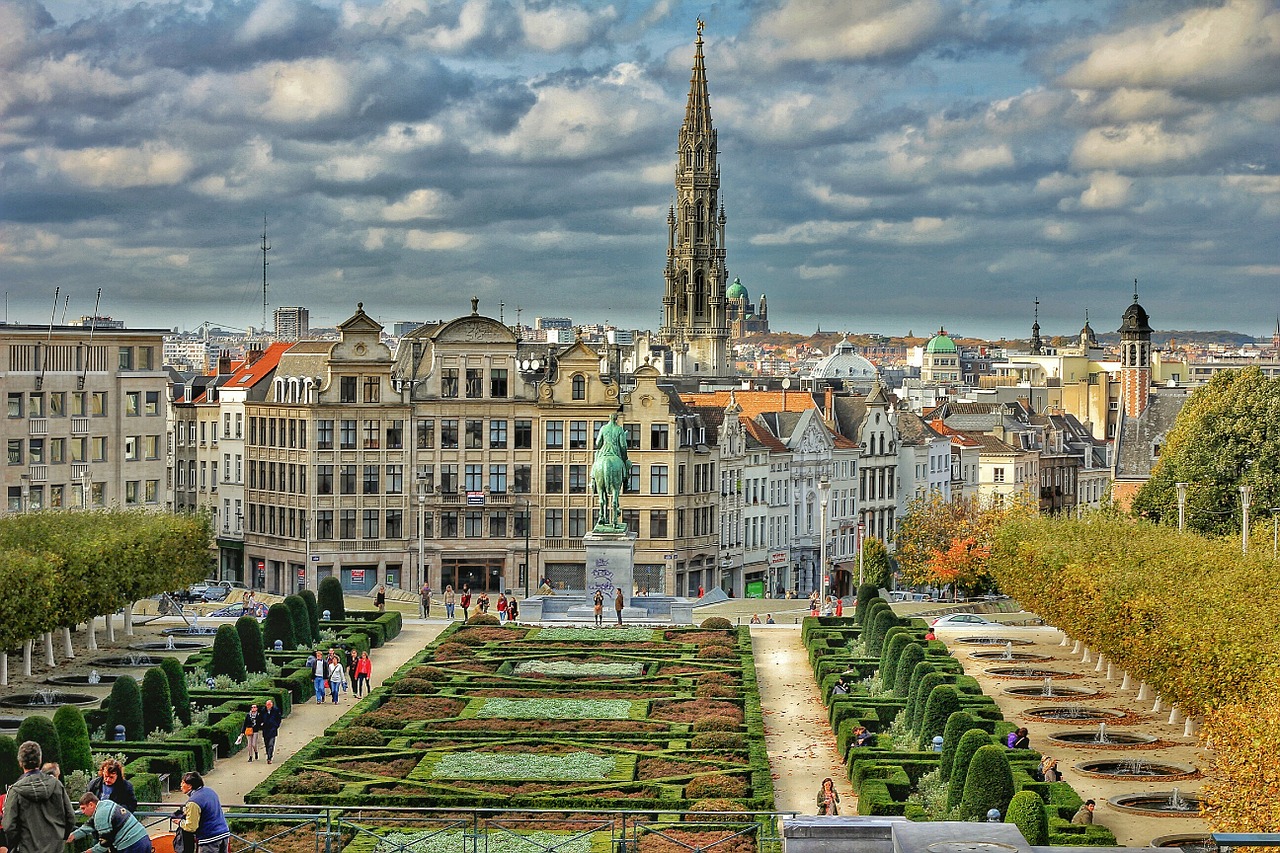Brussels wears three impressive hats, as the capital of Flanders, Belgium and Europe. It started life as a fortress, then developed into a market square and eventually blossomed into the economic, political and social centre of the Flemish capital.
There’s lots to see in the city from the bizarre comic strip to enjoying its café culture in the Grand-Place. Here is a list of our suggestions:
Grote Markt (Dutch) / Grand-Place (French)
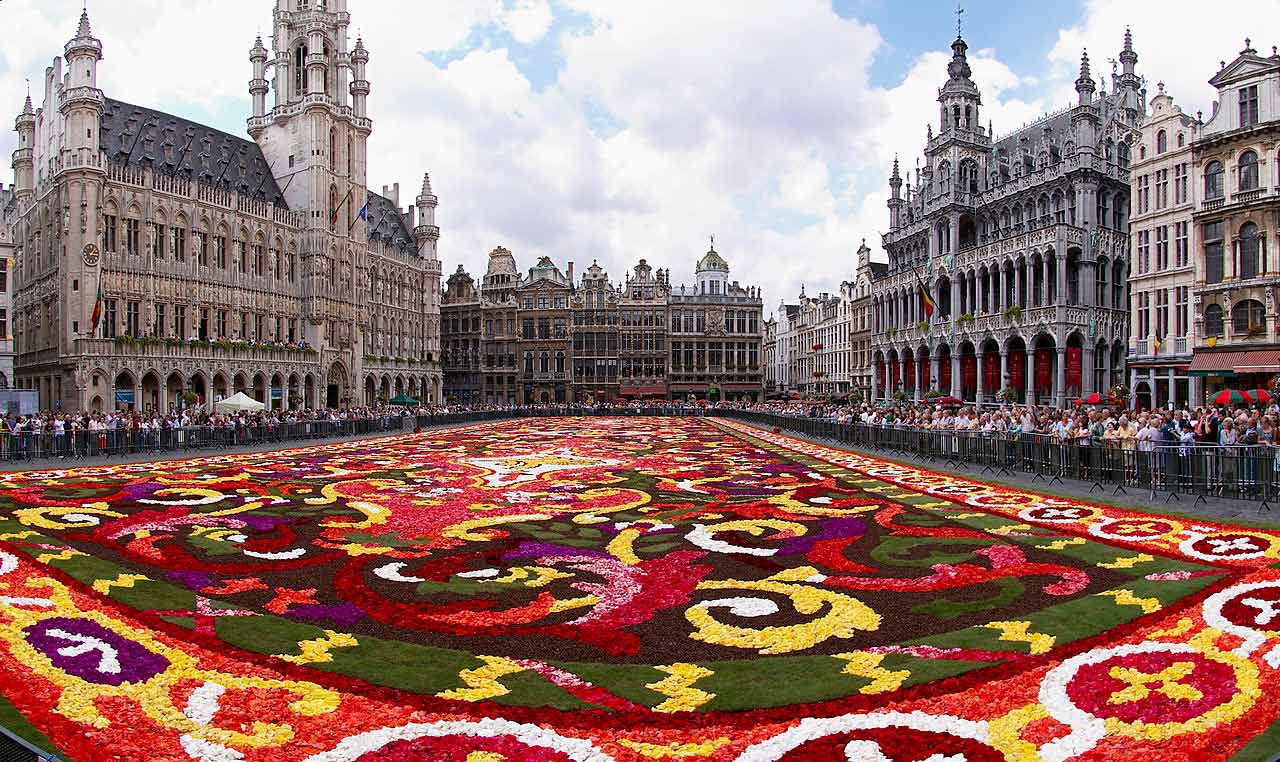
Brussels Flower Carpet 2008 (c) Wouter Hagens
Grand-Place, a UNESCO World Heritage Site, is the main tourist attraction of the City of Brussels but its beginnings were less than glamourous.
The area was just a swampy sandbank between two brooks, known as ‘broek sella’ which gave Brussels its name. The sandbank was reclaimed and turned into ‘Niedermerckt’ (lower market) and sold French and English textiles, French wines and German beer.
In the Middle Ages, wooden houses were built around the market and by the 14th century, wealthy families took to building stone mansions which led to the market developing into the main commercial administrative centre. The town hall came in 1402 and by now it was also a political centre. This is where dukes, royalty and emperors were received but the square was also the site of executions.
Today the Grand-Place is a beautiful, wide-open cobbled medieval and is Brussels’ main market square. It is a great place to hang out and admire the elegant guild houses which replaced all the wooden homes. Many have admired its beauty including Victor Hugo and Baudelaire who rhapsodised about its charm and appealing looks.
There is a daily flower market between March and October and often accompanied with concerts and a light show in the evening.
Every two years, during the third week of August (next one will take place 13-16 August 2022), Belgian begonia cultivators decorate the Grand-Place with a beautiful flower carpet using around 750,000 begonias. Visitors are greeted with 3,200 square feet of amazing plant tapestry depicting a theme.
The square is where daily business is done and where a flurry of local bars and cafés are a superb example of top quality café culture.
Hôtel de Ville – Town Hall
While at the Grand-Place don’t forget to visit the Gothic Hôtel de Ville. It dates back to 1402 and is the seat of civic government. It is an attractive building with arched windows, towers and adorned with sculptures including St Michael slaying a she-devil. If you are feeling energetic, climb the 96 metre high Brabantine Gothic tower and enjoy the amazing views over the city.
Address: Grand-Place
Open: Apr-Sept Tues-Wed 3:15pm, Sun 10:45am and 12:15pm; Oct-Mar Tues-Wed 3:15pm; guided tours in English: 3pm on Wed, 10am and 2pm on Sun
Entry: 5 euros, free for children under 6
Manneken-Pis – ‘Pissing Boy’ aka Petit Julien
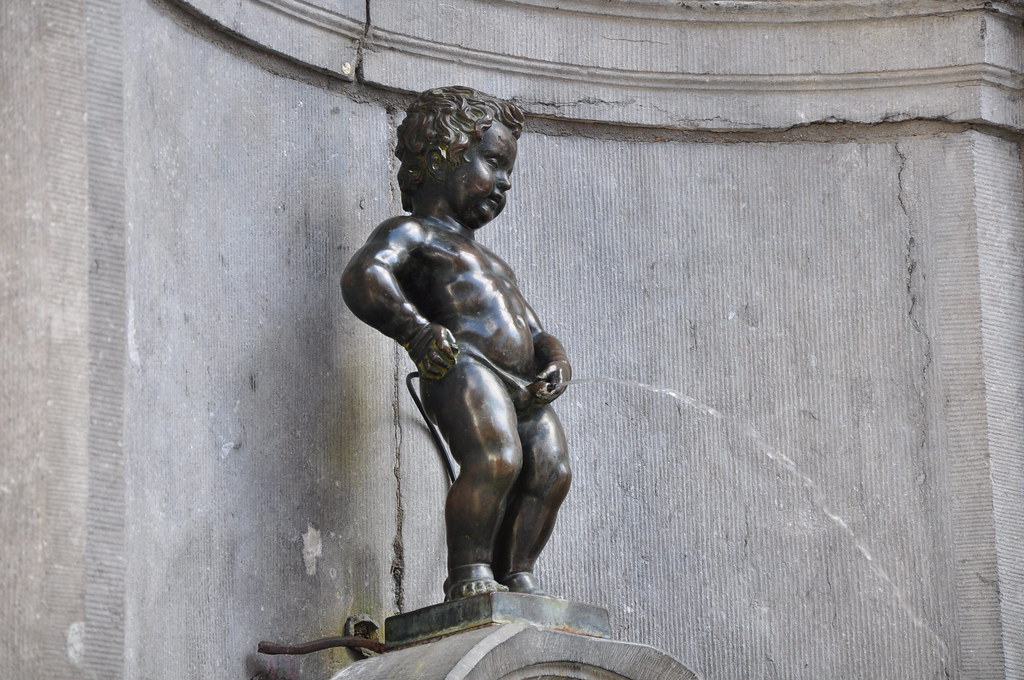
Manneken Pis (c) flickr/Francisco Antunes
The cheeky, chubby-cheeked Manneken-Pis (which means Pissing Boy in Dutch) is a major character in the folklore of Brussels. He is probably Brussels’ most photographed bronze fountain sculpture e, yet it is only 60cm high.
Manneken-Pis was designed by Jerome Duquesnoy and put in place in 1618. The water emerges from a tiny metal penis that points at the viewer. He is usually stark-naked but sometimes he gets dressed. He has an impressive wardrobe of 600 outfits displayed in the Maison du Roi. The one on view is a replica. and the original is kept in the Brussels City Museum
Address: Corner of rue de l’Etuve and rue Chêne.
City Museum – Maison du Roi (French) – Broodhuis (Flemish)
The French name of Maison du Roi is translated as ‘the Kings House’ but although the building is a richly ornamented masterpiece, no royalty ever lived here. The Flemish called it ‘The Bread House’ because the house replaced the town’s Bread Market which had been there for hundreds of years.
This museum is dedicated to the history of Brussels, and if you have already seen the Manneken-Pis, in here you can take a look at his costumes. The history of Brussels is told over three floors from the Middle Ages to date.
Address: Grand-Place (in front of the Town Hall)
Open: Tue-Sun 10am-5pm (open until 8pm on Thur)
Closed: January 1; May 1; November 1, 11; December 25
Entry: 4 euros (free for under 18s on weekends!)
Centre Belge de la Bande Dessinée – Belgian Comic Strip Center

Belgian Comic Strip Center (c) wikimedia/Bd-blogeur
Did you know that Belgium has more comic strip artists per square kilometre than any other country? If you love cartoons, you may appreciate this museum dedicated to the comic strip.
It is housed in the Waucquez Warehouse, a masterpiece in itself, designed by Art Nouveau architect, Victor Horta. You will be taken on the journey a comic strip artist has to make from concept to shop. There’s over 5000 original drawings and an entire section to Belgium’s famous cartoon character hero – Tin Tin.
Incidentally, you can see six dramatic, surprising and amusing cartoon murals painted on gable ends around the city. These were commission by the city itself. Pop into the tourist office, located in the Town Hall, to get a map.
Address: 20 Rue de Sables/Zandstraat
Open: 10am-6pm every day except Monday
Entry: Adults 8 euros; 12-18 year olds 6 euros; under 12s 3 euros.
Heysel Park and the Atomium
Heysel park, located in the west of Brussels, is dedicated to recreation and leisure. In 1985, the European Champions Cup tragedy took place in the Heysel stadium killing several spectators. It has been redesigned since then and renamed Stade Roi Baudoin (King Baudoin Stadium).
One of the highlights of the park is the Atomium. This is a glistening 102 metre (335 ft) high model of an atom made out of chrome and steel designed by André Waterkeyn. To really appreciate this structure, take time to gaze up and enjoy the sheer enormity.
It was erected for the 1958 World Fair to symbolise a new ‘atomic age’. It is an accurate depiction of an iron molecule that has been magnified 165 billion times. It comprises nine 18 metre diameter steel spheres connected by tupes, all of which contain exhibits.
It is probably more impressive on the outside than inside but a high-speed, glass-roofed lift takes visitors to the top in just 23 seconds where you can stop for a beer and a snack, take in the views and then get the escalators down stopping off at the various spheres.
Get your Brussels Atomium Admission Ticket here
Address for Atomium: Boulevard du Centenaire, Laeken
Open: every day, 10am-6pm
Entry: 12 euros for adults; 8 euros for 12-18 year olds; 6 euros for 6-11 year olds; free for children under 6
Getting there: Heysel Metro
Mini-Europe
Next door to the Atomium is Bruparck, a 25 hectare leisure park of several amusements and attractions. This includes a 27 cinema complex called Kinepolis, an all-around Imax screen, a planetarium and a water park called L’Oceade plus a clutch of eateries in ‘The Village’.
Pride of place though goes to the display of some of the most famous and symbolic buildings of the countries of the European Union at 1/25th of the original size. You will see gondolas, a TGV train on its way to Paris even hear the unmistakable chimes of Big Ben.
Address: Boulevard du Centenaire, Laeken
Open: Open every day from 9h30 until 18h00m (last entrance 17h00)
Entry: 12.10 euros
Getting there: Heysel Metro
Basilica of the Sacred Heart (Koekelberg Basilica)
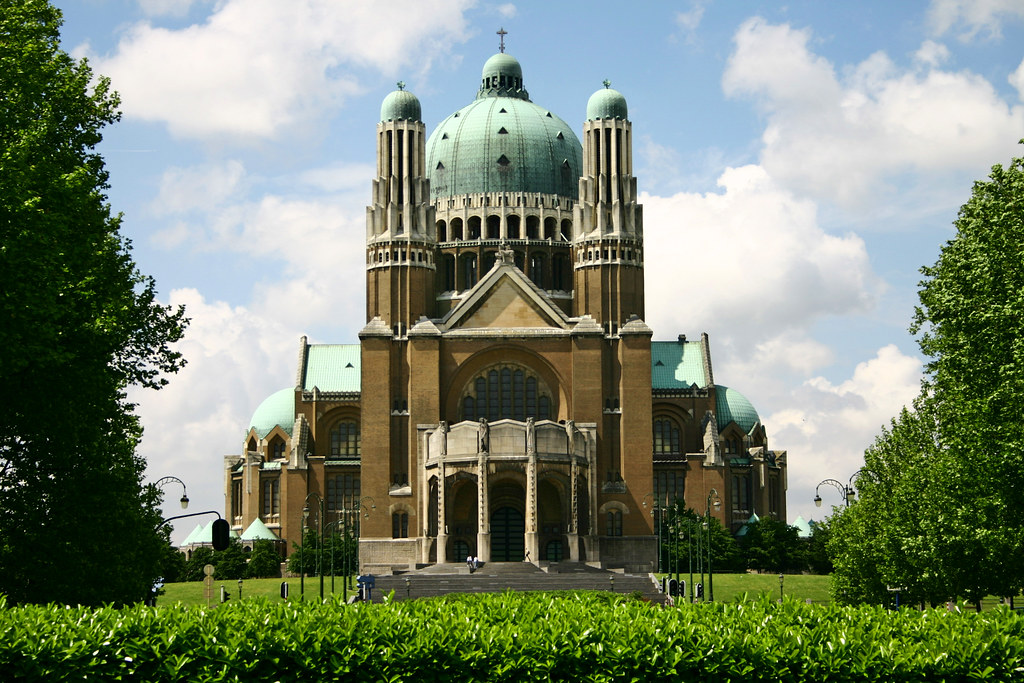
Basilica of the Sacred Heart, Brussels (c) flickr/Chrstian Stock
This Art Deco church is the fifth largest church in the world, located in the Koekelberg municipality of Brussels. Its impressive dimensions (89 metres high and 167 metres long) look out over the Parc Elisabeth. Though it is modelled on the Sacré-Coeur in Paris it is made of concrete, sandstone and red-brick and, unlike the original, is not gleeming white. King Leopold decided to build it in 1902 and he laid the first stone in 1905. It was finally completed in 1971 in time to commemorate the 75th anniversary of Belgian independence.
The cupola platform, which has a diameter of 33 metres, gives an excellent view over Brussels and the surrounding area.
Address: Boulevard Leopold II
Open: 8am-6pm April to September and 8am-5pm October to March
Getting there: Metro Simonis then bus 87
Royal Museums of Fine Arts – Musées Royaux des Beaux Arts
This is, in fact, two museums. The Museum of Ancient Art founded by Napoleon and is particularly noted for its display of the geat works of Flanders. The other is the Museum of Modern Art. This was added in 1984 and comprises eight floors, many of which are underground. Between them, they offer over 600 years of fine art comprising paintings, sculptures and drawings.
Address: Rue de la Régence 3
Open: Tue-Sun 10am-5pm (ticket office closed at 4:30pm)
Closed: Mondays and January 1st, 2nd Thursday of January, 1 May, 1 November, 11 November, 25 December
Entry (combined ticket for both museums): Adults 13 euros; Children 3 euros (free for under 6)
Getting there: Metro Central station of Park (line 1), Tram 92, 84, Bus 27,29, 38,95
Shopping
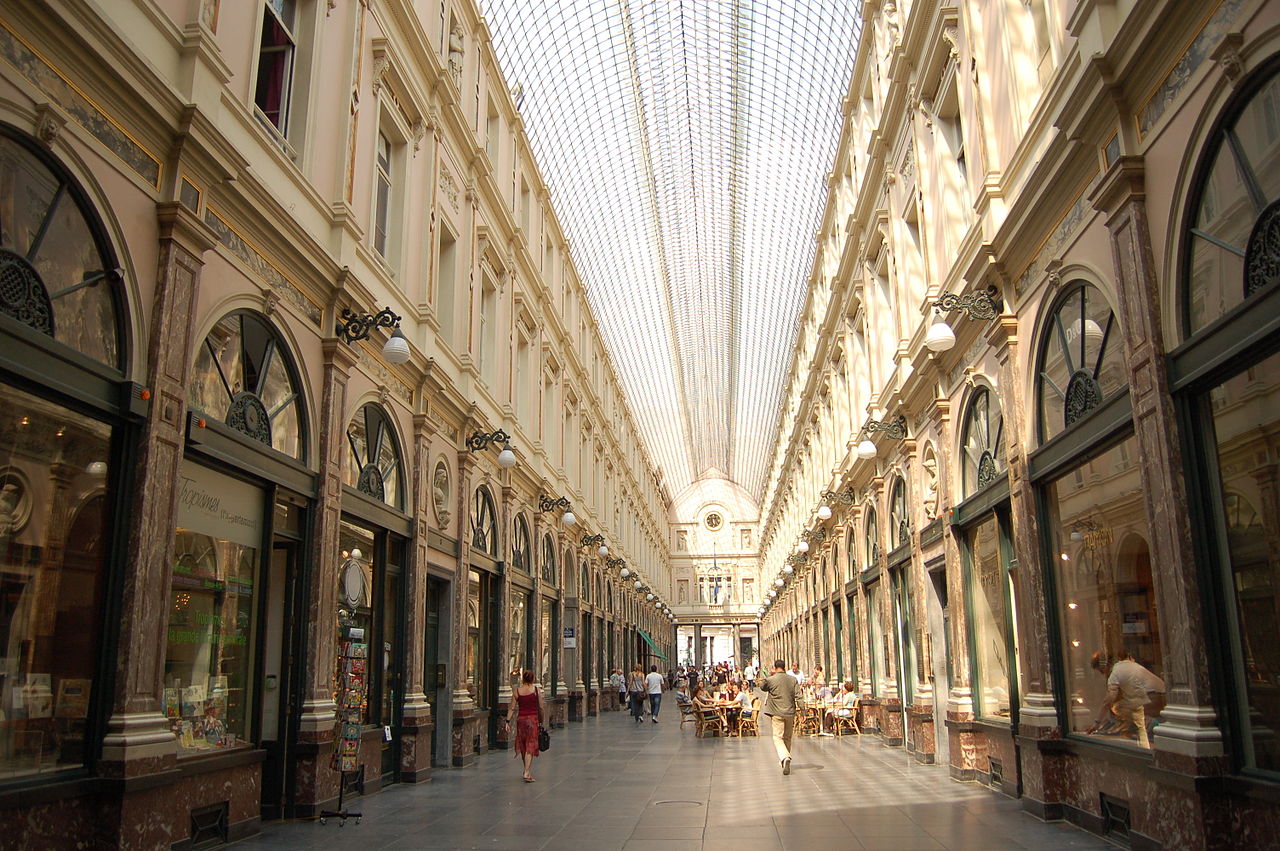
Galeries royales Saint-Hubert, Brussels (c) wikimedia/KoS
No city break would be complete without a spot of shopping.
Antique lovers should descend upon the antique market in Place du Grand Sablon where on the square and the streets panning out from the square, the discerning antique lover may find that special piece. Rue de la Paille, Rue des Minimes and Rue de Rollebeek are particularly interesting.
Brussels has its own flea market – the Jeu de Balle Flea Market. Rummage around here for gems, secondhand goods and period furniture bargains.
Belgium chocolates are a must buy. For pralines go to Chocolatier Mary, for a tearoom experience visit Wittamer and for a shop of exceptional displays try Pierre Marcolini. Some chocolates are encrusted with real, yet edible, gold.
If it has to be designer fashion then head for the Galleries. There are three Galeries Saint Hubert, Galeries du Roi and Galeries de la Reine. They are worth popping into just to take a look at the amazing glass roof.
Antique Market, Place du Sablon
Chocolatier Mary, 73 Rue Royale
Wittamer, 12-13 Place du Grand Sablon
Pierre Marcoloni, 39 Place du Grand Sablon
Flea Market, Place Jeu de Balle, Marolles district.
Galeries are located between Rue du Marche aux Herbes and Rue de l’Ecuyer
Where to Stay
READ ALSO: 5 of the best hotels in Brussels
HOTEL REVIEW: Steigenberger Wiltcher’s, Brussels
Booking.com
Booking.com
Getting There
If you are flying, note that Brussels has two airports: Brussels International (the main airport) and Brussels Charleroi (about 46km/29mi South of Brussels, but has the advantage of being served by several low cost airlines).
If you are driving from the UK catch a DFDS ferry from Dover to Calais (starting from £35 for a car + 9 people each way). It’s a 4-hour drive from there through the Flemish town of Lille then through Belgium and onto the E25 to Luxembourg.
Useful Links
- Grand-Place, a UNESCO World Heritage Site
- Brussels’ Flower Carpet
- Belgian Comic Strip Center
- Atomium
- Mini-Europe
- Basilica of the Sacred Heart
- Royal Museums of Fine Art
Source : https://www.thetravelmagazine.net/brussels-top-10/

